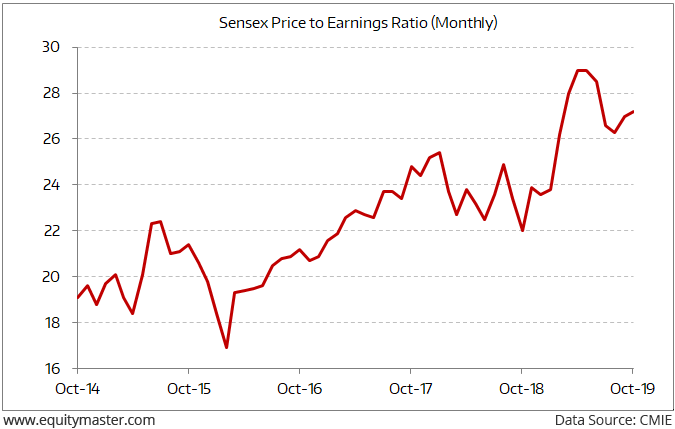India's Third Giant Leap
This Could be One of the Biggest Opportunities for Investors
- Home
- Todays Market
- Indian Stock Market News November 21, 2019
Sensex Remains Rangebound; Bharti Airtel and ONGC Top Losers Thu, 21 Nov 12:30 pm
Stock markets in India are presently trading flat. The BSE Sensex is trading down by 31 points and the NSE Nifty is trading down by 14 points. The BSE Mid Cap index is trading down by 0.1%, while the BSE Small Cap index is trading flat.
Among the sectoral indices, telecom stocks and oil & gas stocks are witnessing selling pressure. Automobiles stocks and IT stocks are trading in green.
Speaking of the Sensex touching record high, how expensive is the Sensex at current levels? What has the trend been in recent years?
It would be interesting to see how the valuation of the index has moved over the last five years.
The chart below maps the price to earnings ratio of the Sensex from October 2014 to now.
How Pricey Is the Sensex Now?
Here's what Ankit Shah wrote about this in a recent edition of The 5 Minute WrapUp...
- It is worth noting that the Sensex has gained 44% over the last five years, compounding at an annual rate of 7.6% (excluding dividends).
Not quite impressive.
During the same period, the Sensex price to earnings ratio has mostly been in a rising trend, except some intermittent declines.
Between October 2014 and now, the gain in the Sensex price to earnings ratio is 42%. That means that the gains in the index have mostly come from expansion in the valuation multiple, and just meagerly from increases in earnings.
So, before taking the current market bullishness for granted, do weigh in the fact that the Sensex is quite expensively priced.
Also, amid the mood swings of Mr. Market witnessed lately, Tanushree Banerjee in the video below talks about the Rebirth of India phenomenon and how 3 specific trends are racing ahead even in these gloomy times.
Tune in to find out more...
In the news from the currencies space. The rupee today opened 3 paise down at 71.84 against the US dollar amid rising crude oil prices and fresh concerns over US-China trade tensions that supported demand for the safe-haven greenback.
The local currency declined 10 paise to close at 71.81 against the American currency on Wednesday, in line with weak Asian currencies.
In the last couple of sessions, rupee consolidated in a narrow range despite gains in domestic and global equities following optimism related to trade talks between US and China.
But yesterday, US equities came under pressure following reports that 'Phase One' deal between the two major economies could slide into next year.
Reportedly, China is pushing for more extensive tariff rollbacks and the Trump administration counters with heightened demands of its own.
Euro and Pound in the last few sessions have been trading positive ahead of the important preliminary manufacturing and services PMI number that will be released in tomorrow's session.
Today, from the Euro zone, ECB minutes will be in focus and expectation is that the central bank will continue to maintain a dovish stance and could extend gains for the currency.
Let's wait and watch how this pans out.
Moving on to the news from the automobiles sector. As per the rating agency India Ratings and Research, implementation of the BS-VI emission norms from April 2020 could lead to some short-term headwinds for the commercial vehicle (CV) segment.
Considering the sharp year-on-year fall in the sales volumes of CVs, especially since May 2019, the underwhelming pace of industrial activity and the higher cost of ownership of a BS-VI compliant CV, the implementation of BS-VI could add to the sector's woes.
Furthermore, given the excess supply and muted demand-side fundamentals in the economy, the rating agency believes the pre-buying of BS-IV CVs till end of the fourth quarter of the current fiscal is unlikely to be meaningful as compared with the earlier occasions when new emission norms had been implemented.
It said for fleet owners, the ownership of BS-VI vehicle would be credit neutral as the benefits from fuel efficiency and maintenance would largely be offset by higher debt repayments.
It noted the revised axle load norms led to inorganic capacity expansion in the system while demand-side fundamentals have remained fairly muted as evident from the decline in the index of industrial production and the decrease in the aggregate volumes of manufacturing companies.
Besides, the agency said that demand for CVs would remain challenged in the near term by the slowing growth of industries and the economy in general as well as by the impact of the extended monsoon on agricultural produce and rural demand.
Automobile stocks are trading mixed with Eicher Motors and TVS Motors leading the gainers.
To know what's moving the Indian stock markets today, check out the most recent share market updates here.
For information on how to pick stocks that have the potential to deliver big returns, download our special report now!
Read the latest Market Commentary



Equitymaster requests your view! Post a comment on "Sensex Remains Rangebound; Bharti Airtel and ONGC Top Losers". Click here!
Comments are moderated by Equitymaster, in accordance with the Terms of Use, and may not appear
on this article until they have been reviewed and deemed appropriate for posting.
In the meantime, you may want to share this article with your friends!